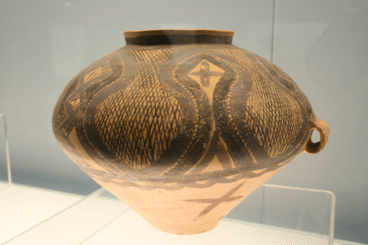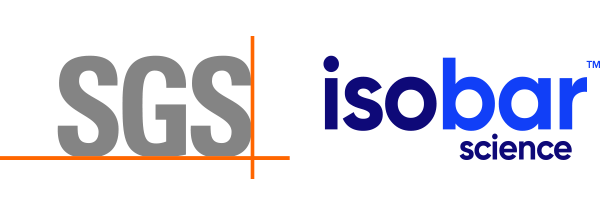Isotopic Analysis of Pottery & Food Residues
Archaeological pottery samples can be provenanced through the analysis of the origin of its component clay and temper. This can be done using various methods – but most powerfully through isotope geochemistry, including through strontium and lead isotope systems. Principally this is done by comparing the composition of pottery shards to isoscapes or reference pottery groups – those of known clay or raw material origin from specific pottery production regions (Renson et al. 2013). This is possible because the transformations during the manufacturing process occur without fractionation and the raw materials used to develop ancient pottery tend to be unaffected by diagenesis/post-burial isotopic alteration in the systems of interest (Renson et al. 2021). This means that they retain their original isotopic composition and can thus be traced back to their originating outcrop/sediments. In the case of lead isotopes, the ratios of 207Pb/204Pb are compared to 206Pb/204Pb between the pottery sample and reference groups or raw materials as similar origins will be represented as clusters within such diagrams (e.g. Figure 1; Renson et al. 2016). Where post-depositional effects do exist they are often mitigated through the measurement of multiple isotope systems that may not be uniformly altered which underscores the importance of a multi-systems approach.
Beyond the pottery itself, the organic residue along the surface of pottery can provide details on the use of pottery and dietary changes through time. Organic compounds (such as lipids) on pottery surfaces are commonly derived from the cooking or storage of food stuffs; thus the analysis of carbon and nitrogen isotopes can provide details on the trophic level and general origin (i.e. marine or terrestrial) of organisms consumed (Yoshida et al. 2016; Tache et al. 2021). For example, Craig et al. (2013) utilized these methods to track the hunter-gatherer behavior of the early-adaptor Jōmon people living on the major islands of Japan in the Late Pleistocene (15,000-11,800 cal BP) – demonstrating that high-trophic-level aquatic organisms were common food sources across a range of regions. More efficient exploitation of this productive yet geographically limited food source likely resulted in the intensification and development of new pottery usage. Furthermore, the analysis of δ13C in animal fat residues can provide details on the diet and physiology of animals, allowing grouping by types (e.g. ruminant vs. non-ruminant; Mukherjee et al. 2007, 2008).  Plant types cooked can also be predicted as different varieties (C3, C4, CAM) have distinct carbon isotopic signatures.
Plant types cooked can also be predicted as different varieties (C3, C4, CAM) have distinct carbon isotopic signatures.
Pottery is typically dated using radiocarbon (14C) dating. Entire ceramic pieces are not the most optimal sample for dating as they contain numerous components which have different radiocarbon ages (e.g. clay/sediment, animal fat/bone, plant material, shells) and come into contact with possible contaminants during production (e.g. carbon from kiln fuel) (Berstan et al. 2008; Zaitseva et al. 2009). More optimally, the residues along the pottery wall will provide a more accurate date as they represent the period of pottery use (Heron & Evershed, 1993) including plant oils, marine oils and animal fats. If food residue cannot be extracted, bulk shard organics can also be analyzed (providing a minimum age result).
| Isotope | Sample Size | Preparation |
| Lead (204Pb, 206Pb, 207Pb, 208Pb) | 100-150mg (ceramics) | Homogenized, packaged in plastic or glass vials |
| Strontium (87Sr/86Sr) | 100-150mg (ceramics) | Homogenized, packaged in plastic or glass vials |
| Radiocarbon (14C) Dating | 10-100mg (burnt food residue) | Ziplock bags |
| Carbon (δ13C) | (included in radiocarbon dating) | Ziplock bags |
Contact us today to discuss how isotopes can be used in your pottery research!
References
Berstan, R., Stott, A.W., Minnitt, S., Ramsey, C.B., Hedges, R.E. and Evershed, R.P., 2008. Direct dating of pottery from its organic residues: new precision using compound-specific carbon isotopes. Antiquity, 82(317), pp.702-713.
Craig, O.E., Saul, H., Lucquin, A., Nishida, Y., Taché, K., Clarke, L., Thompson, A., Altoft, D.T., Uchiyama, J., Ajimoto, M. and Gibbs, K., 2013. Earliest evidence for the use of pottery. Nature, 496(7445), pp.351-354.
Heron, C. and Evershed, R.P., 1993. The analysis of organic residues and the study of pottery use. Archaeological method and theory, 5, pp.247-284.
Mukherjee, A.J., Berstan, R., Copley, M.S., Gibson, A.M. and Evershed, R.P., 2007. Compound-specific stable carbon isotope detection of pork consumption applied to the British Late Neolithic. Antiquity, 81, pp.743-754.
Mukherjee, A.J., Gibson, A.M. and Evershed, R.P., 2008. Trends in pig product processing at British Neolithic Grooved Ware sites traced through organic residues in potsherds. Journal of Archaeological Science, 35(7), pp.2059-2073.
Renson, V., Jacobs, A., Coenaerts, J., Mattielli, N., Nys, K. and Claeys, P., 2013. Using lead isotopes to determine pottery provenance in Cyprus: clay source signatures and comparison with Late Bronze Age Cypriote pottery. Geoarchaeology, 28(6), pp.517-530.
Renson, V., Neff, H., Martínez-Cortizas, A., Blomster, J.P., Cheetham, D. and Glascock, M.D., 2021. Lead and strontium isotopes as tracers for Early Formative pottery exchange in ancient Mexico. Journal of Archaeological Science, 126.
Taché, K., Jaffe, Y., Craig, O.E., Lucquin, A., Zhou, J., Wang, H., Jiang, S., Standall, E. and Flad, R.K., 2021. What do “barbarians” eat? Integrating ceramic use-wear and residue analysis in the study of food and society at the margins of Bronze Age China. Plos one, 16(4).
Yoshida, K., Kunikita, D., Miyazaki, Y., Nishida, Y., Miyao, T. and Matsuzaki, H., 2013. Dating and stable isotope analysis of charred residues on the Incipient Jomon pottery (Japan). Radiocarbon, 55(3), pp.1322-1333.
Zaitseva, G., Skripkin, V., Kovaliukh, N., Possnert, G., Dolukhanov, P. and Vybornov, A., 2009. Radiocarbon dating of Neolithic pottery. Radiocarbon, 51(2), pp.795-801.
Image 2: https://en.wikipedia.org/wiki/Pottery#/media/File:Neolithic_Majiayao_Culture_Pottery_03.jpg
